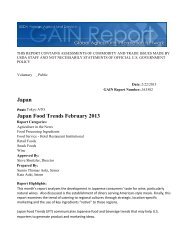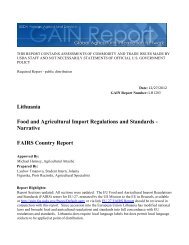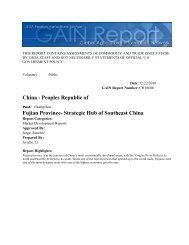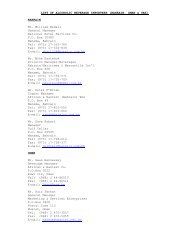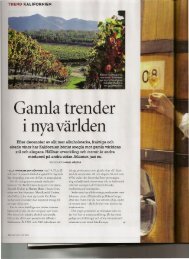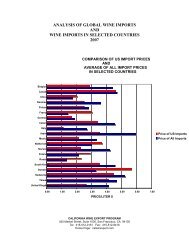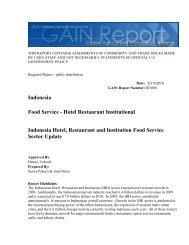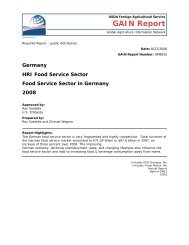Brazil Wine Market Report JBC EMP July 2011 - California Wine ...
Brazil Wine Market Report JBC EMP July 2011 - California Wine ...
Brazil Wine Market Report JBC EMP July 2011 - California Wine ...
You also want an ePaper? Increase the reach of your titles
YUMPU automatically turns print PDFs into web optimized ePapers that Google loves.
The Effect of <strong>Brazil</strong>ian Trade Policy on Imported <strong>Wine</strong><br />
18<br />
<strong>Brazil</strong>ian <strong>Wine</strong> <strong>Market</strong> <strong>Report</strong><br />
<strong>Brazil</strong> is a party to a plurilateral free trade agreement called MERCOSUR. This agreement<br />
represents the Southern Cone Common <strong>Market</strong>. Countries involved in the agreement<br />
include Argentina, <strong>Brazil</strong>, Paraguay and Uruguay with Chile as an associate member.<br />
MERCOSUR created a customs union between member countries that provided for the<br />
elimination of certain trade barriers at the end of 1995. A common external tariff has been<br />
implemented upon all products coming in from outside the region. The mutual tariffs set for<br />
wine by the parties’ trade agencies were imposed at 20 percent.<br />
Argentinean producers profit in sales to <strong>Brazil</strong> since their wines are exempt from import<br />
tariffs under the MERCOSUR trade agreement. Because of this, Argentinean producers<br />
began intensely marketing their neighbor country. Even Chilean wines have enjoyed a<br />
decrease in import tax through a bilateral trade agreement with <strong>Brazil</strong> that will reach tax<br />
exemption in <strong>2011</strong>. In 2006, the <strong>Brazil</strong>ian government agreed to reduce import taxes from<br />
27 percent to zero percent in exchange for the Chilean agreement to purchase buses from<br />
<strong>Brazil</strong> for the widening tourism movement. These tax benefits have increased the<br />
popularity of Argentinean and Chilean wines while harming domestic sales and other<br />
imported wines at the same time.<br />
Consumption Analysis<br />
Value and Volume Estimates<br />
For 2009, <strong>Brazil</strong>ian wine consumption was 310.5 million liters, at a value of US $2,970<br />
million. Consumption for <strong>2011</strong> is estimated at 314 million liters, and consumption for 2014 is<br />
estimated at 332.9 million liters. On a per capita basis, <strong>Brazil</strong>ians consume 1.8 liters of wine<br />
per annum, a small figure compared to the neighboring country of Argentina at 23 liters per<br />
annum. Economists recognize a steady 10 percent increase in consumption in both 2009<br />
and 2010 and predict there will be a similar increase in <strong>2011</strong> and 2012.<br />
<strong>Brazil</strong>ian <strong>Wine</strong> Consumption<br />
Table A<br />
<strong>Brazil</strong>ian <strong>Wine</strong> Consumption- Historical and Projected<br />
By Volume (million liters)<br />
Year Total Imported Domestic<br />
2004 341.00 64.40 276.60<br />
2005 395.30 39.50 355.80<br />
2006 375.10 49.90 325.20<br />
2007 363.50 59.60 303.90<br />
2008 344.90 56.60 288.30<br />
2009 324.30 57.80 266.50<br />
2010 310.50 73.70 236.80



